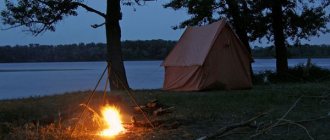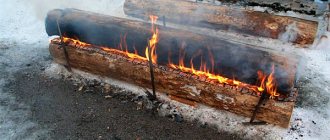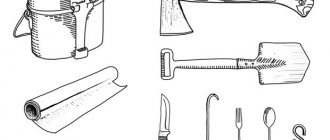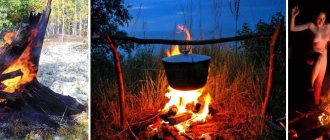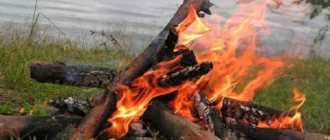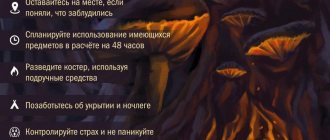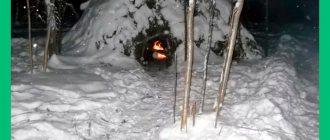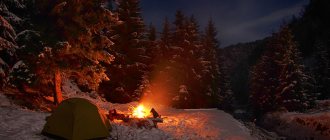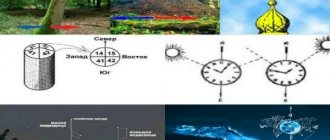Making fire using traditional methods
The main sources of fire were and remain matches and a lighter. Matches are included in any survival kit. The following types are distinguished:
- Resistant against wind and moisture (hunting).
- Having a long piece of wood.
- Non-grit options that generate fire from friction against any surface: stone, wall. They can be recognized by the double coloring of their heads.
To prevent matches from failing at the right moment, you need to follow some simple recommendations:
- Proper storage: in airtight containers. To avoid ignition, avoid their friction and strumming.
- For economical use, the match is split in half and a fire is started by pressing the sulfur head to the ignition surface.
- A damp match can be dried by rubbing it over dry, clean hair.
- A candle will help you start a fire and save matches.
- It's always safer to have a spare box of matches.
- Ordinary matches must be additionally processed, otherwise there is no point in taking them with you on a hike.
Lighters , in turn, can be:
- alcohol;
- gasoline;
- gas.
You can take any of them, but, most importantly, they are not cheap. With the latter, building a fire will be delayed, and “you won’t be able to cook porridge.” A couple of flints in reserve would also be useful. They are suitable for making a “fire pencil”, which produces a spark from friction against any hard surface.
Making fire using flint, steel or flint
Another method, rooted in centuries-old history: making fire using flint. Flint was especially popular in the eighteenth century before the invention of ordinary matches. To strike a spark and make a fire, it is enough to have a silicon stone. A couple of blows are enough and you can bring tinder from leaves or dry grass to ignite the fire. Flint was often used in camping conditions or in war. Also, many people carry it in their EDC kits. The chair must be metal.
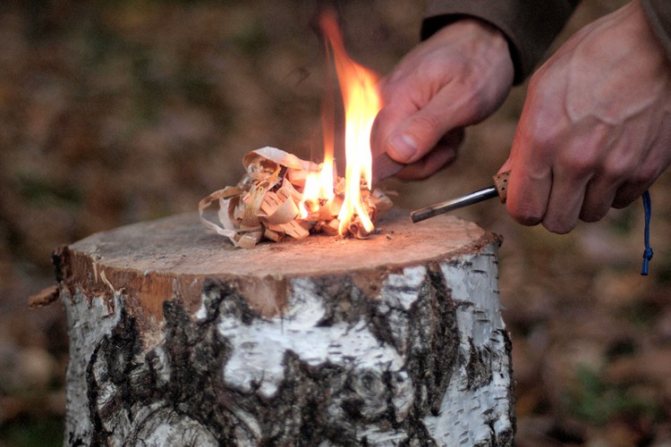
If you're lucky, you can make sparks for a future fire using silicon. Flint, consisting of hard rock minerals, can be easily found among stones. By the way, flint steel was used in ancient firearms.
Procedure for making a fire
- Prepare tinder or any flammable material:
- reed, especially its top;
- dry grass;
- paper;
- textile;
- cotton wool;
- small birch bark;
- crushed tinder fungi;
- needles;
- fir cones.
- Collect brushwood and prepare firewood.
The first option ignites easier and faster, but does not burn for long. The main fuel is firewood. First, dry and thin ones are used, and then you can add raw ones, the heat will evaporate the excess water, and the fire will not go out.
- Prepare a place for the fire.
It is necessary to avoid options near dry trees, tents, and sleeping bags. The selected area with a diameter of 1-1.5 m is cleared, you can dig a small hole to make a fire. If the ground is wet or covered with snow, make a raised platform from fresh branches, earth or stones.
- Build the “frame” of the structure.
Whatever type of fire a person chooses, several rules should be followed:
- leave fire access to oxygen;
- use as dry materials as possible;
- Use brushwood to light firewood.
- Get fire and start a fire.
The spark hits the tinder, then small brushwood ignites and, as it burns, it ignites thicker branches and firewood. If necessary, a low flame should be maintained by slowly fanning.
What are the benefits of potassium permanganate for plants?
In addition to its use for medicinal purposes, potassium permanganate, due to its disinfecting effect, is actively used by summer residents in the garden.
Disinfection of seeds with potassium permanganate
Most often, planting material (seeds and bulbs) of most flower and vegetable crops is disinfected in a weak pale pink solution (0.5%), soaking them, depending on the recommendations of agronomists, for a period of 20 minutes to several hours. In addition to disinfection, this procedure helps accelerate seed germination, increasing the germination rate of plantings, provides the need for manganese at the initial stage of the growing season, and strengthens plant immunity to various infectious diseases.
The benefits of potassium permanganate for soil
A solution of potassium permanganate (0.2%) is used to treat the soil both in open beds and in greenhouses, in order to destroy the causative agents of many plant diseases. For this purpose, the prepared solution is spilled on the soil in the beds, or before planting seedlings, 1 liter of this composition is poured into each hole.
Potassium permanganate in the fight against diseases of garden crops
A 3% solution of potassium permanganate is actively used to combat powdery mildew on cucumber plantings. Plants are treated every 3 days. To get rid of powdery mildew on berry bushes (gooseberries, currants), a slightly different composition is prepared: 50 grams of potassium nitrate and 3 grams of potassium permanganate are diluted in a standard bucket of water. Treating plants with a solution significantly stops the development of diseases.
Caution when using potassium permanganate:
It should be understood that such a potent substance, if the recommended dosages are not followed, can cause significant harm to health. High concentrations of potassium permanganate when ingested can cause swelling of the mucous membranes of all organs of the gastrointestinal tract, mouth and throat, as well as increased vomiting and stomach upset
Therefore, exercise extreme caution when using potassium permanganate. Be sure to store potassium permanganate out of the reach of children.
Keep in mind that potassium permanganate, when interacting with some organic substances, can form explosive mixtures. That is why crystals should be stored only in glass containers with tightly ground stoppers. It is recommended to store the solution prepared for future use in a shaded place in dark glass bottles, since when exposed to sunlight and daylight, the composition quickly decomposes, losing all its properties.
How to start a fire with a lens?
The sun is a limitless source of energy. In cloudless weather, you can start a fire even with a small piece of glass. The main thing is to concentrate the sun's ray at one point. Placed in focus, tinder in the form of a paper napkin or a nest of dry grass will give a flame that only needs to be developed.
Also suitable: a mirror, the bottom of an aluminum can, glasses, a piece of clean ice. The lens can be made from a plastic bag or condom filled with water, which refracts light. All you have to do is use your hands to shape the container with water into the desired shape so that the sun’s ray can focus on one point.
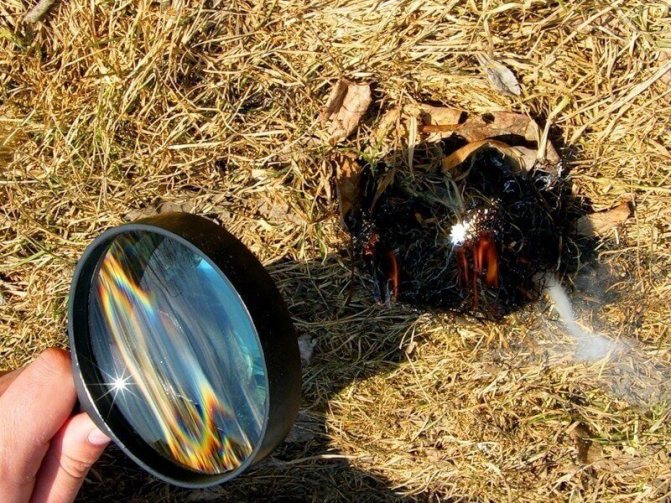
You can also start a fire using a piece of ice. The main thing is to use the warmth of your hands to give it the shape of a biconvex lens. A tin can works on the same principle. Only it does not refract the sun's ray, but reflects it. Before use, the bottom of the jar can be sanded, but it is important not to overdo it so as not to damage the outer shell.
Precautionary measures
Many people do not read the instructions for use of certain products, and this is a mistake. Proper dilution of potassium permanganate crystals consists of the initial dilution of the substance in a small container to a bright crimson color and its thorough dissolution. The second stage is to add a strong liquid to the container where it is intended to be used, in a small amount. The process of dissolving manganese permanganate should be carried out with gloves; the residues should be disposed of or stored out of the reach of children, away from food products. When adding a concentrated solution to a container for use, it must be filtered. Do not pour crystals directly into the bath or use concentrated liquid.
It is necessary to carry out explanatory work with children about the prohibition of trying unfamiliar liquids, substances and playing with them. All these rules are standard for working with all chemicals; if you remember them and follow them, the likelihood of getting a burn will be reduced to zero.
Using chemical reagents, you can make a fire without matches or other means of ignition. For example, it is relatively easy to make fire from sugar and potassium permanganate, potassium permanganate and glycerin - substances that are often found in a tourist first aid kit.

Today in Russia and Ukraine potassium permanganate is prohibited for sale without a prescription and therefore buying it for tourism purposes is more difficult, but still possible.
There are also other ways to produce chemical fire using various substances, which are simply useful to know about. For example:
- Potassium permanganate + sulfuric acid + ethanol. To start a fire using potassium permanganate, drop a few drops of concentrated sulfuric acid onto dry potassium permanganate powder. If you now put cotton wool soaked in ethyl alcohol into the mixture, the cotton wool will catch fire.
- Chromium trioxide + ethanol. A little chromium trioxide is poured onto cotton wool moistened with ethyl alcohol. At the moment of contact of the reagents, the cotton wool ignites.
- Sodium or potassium + water. When one of these metals comes into contact with water, a violent reaction occurs with ignition.
- Potassium chlorate + sugar + sulfuric acid. To produce fire, powdered sugar is mixed with potassium chlorate, after which concentrated acid is dripped onto the resulting mixture. The moment the mixture comes into contact with sulfuric acid, a fire occurs.
- Aluminum + iodine. For this method, you will need to conduct a chemical experiment with crystalline iodine. It is mixed with aluminum powder and a little water is added to the finished mixture - after a short time the mixture catches fire.
In fact, there are many more ways to start a fire using chemical reagents, but almost none of them are suitable for a tourist who finds himself in an emergency situation, because most of the reagents, not only on a hike, but also in a populated area, cannot always be bought.
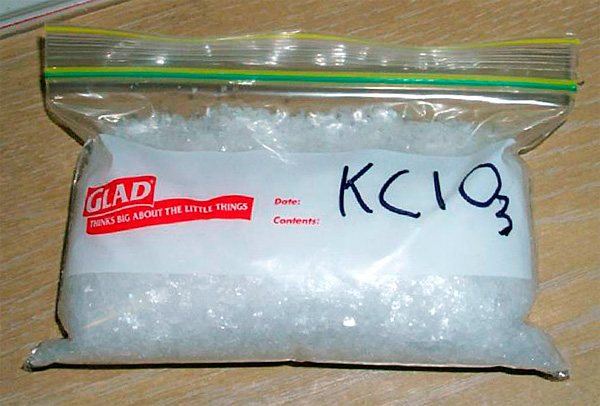
Potassium chlorate ignites when in contact with sulfuric acid and sugar, but try buying it. Moreover, admit it: will you carry it in your backpack along with sulfuric acid?
It is even believed that fire can be started using hydrogen peroxide. This is not true, however: this reaction does not actually cause combustion, but can support it. So, if you add potassium peroxide to hydrogen peroxide, a rapid release of oxygen will begin. And in an oxygen environment, as is known, even a smoldering splinter instantly ignites.
In survival conditions, I don’t see any point in using hydrogen peroxide in this way: it will be more useful if it is used for its intended purpose, that is, for the purpose of disinfecting wounds and scratches.
I know of only a couple of chemical methods of starting a fire without matches and other devices for ignition, which can be implemented in the wild, for example, in a forest, with reagents that are generally available and found in a tourist’s first aid kit. These are methods using mixtures of potassium permanganate + glycerin and potassium permanganate + sugar.
Chemical fire making
You can light a fire using the thermal effect of chemical reactions in which the reactants are:
- Potassium permanganate and sugar (9:1).
- Bertholet salt and sugar (3:1);
- Potassium permanganate and glycerin (1-2 drops). When smoke appears, an additional drop of glycerin is applied, causing the mixture to spontaneously ignite.
- Potassium permanganate and antifreeze. 1 tsp is poured onto the paper. permanganate, add 2-3 drops of antifreeze and, tightly folding the paper, place it on the ground, covering it with tinder. Starting a fire occurs through a slow oxidation reaction accompanied by the release of heat. Large amounts of antifreeze will slow down the chemical reaction. Loosely folded paper will also reduce the temperature inside it.
Some people consider the chemical method of producing fire strange, but in real conditions it works and helps someone.
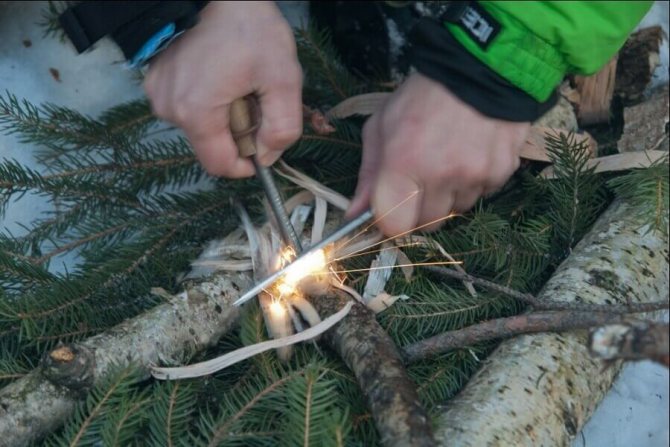
Dry alcohol in tablets, which is often sold in sealed packaging along with hunting matches, will also help to light a fire.
For the next method, take foil and cut a strip. Fold it in half and use scissors to sharpen the fold. This helps create resistance to the electrical current, which is what causes heating and combustion. By attaching the ends of the foil to the poles of the battery, you can light a fire , the main thing is to protect your fingers. This method is more of an exotic method than a real one. It is difficult to imagine a situation in which such an idea could be useful.
You can also light a fire with a cartridge from which you have taken a bullet, shot and part of the gunpowder, and instead filled it with crushed birch bark, dry moss or cotton wool. The shot is fired into the ground next to the arson material. You can also ignite gunpowder poured onto tinder using sparks from a chair.
The main thing is not to forget that the main tool of man has been and remains the brain. He is always with his owner and will help him make fire without matches in order to survive in the most extreme conditions. Therefore, you need to think about safety measures in advance and carefully extinguish the ashes after yourself.
What can act as tinder and wick
In conditions of autonomous existence, when the issue of survival comes first, the primary task is to make fire. However, sometimes the resulting spark goes out before it has time to grow into the flame of a fire. Typically, dry paper is used to maintain the fire. If it is not at hand, the functions of the wick and tinder are performed by:
- cotton wool fluffed or smeared with petroleum jelly, cotton insulation;
- handkerchief;
- old, torn T-shirts, sheets and other rags;
- napkins, wax or toilet paper;
- cotton pads, tampons;
- dried mushroom Tinder fungus;
- wood shavings, small chips;
- old reeds, reeds, cattails, bamboo;
- Birch bark;
- dry grass;
- old dry moss;
- pine needles, fir cones;
- burnt fabric.
If you find yourself without a match or a lighter in the forest, you just need to look around and a suitable means of ignition will be found.
Some people store tinder for future use and then take it with them. Here are their recommendations:
- Store the product in sealed freezer bags. Durable products do not allow moisture to pass through, maintaining the high flammability of tinder.
- When going on a hike, transfer the contents of the bag into a special sealed container. If you leave the tinder in the bag, it will become damp and lose its value.
- Before use, fluff up and separate the material into fibers. This will speed up the formation of a spark and flame.
- Fan the tinder until it chars and full flames appear. Only then add kindling and wood.
Making fire using friction
This “non-match” method came to us from antiquity. Initially, primitive people made fire by rubbing dry pieces of wood against each other for a long time.

Later, they began to carve out a hole in the board, which was lightly sprinkled with dry leaves or grass. Then a rod-stick was inserted there and intensively rotated between two thumbs. This continued until the tinder burst into flames. To speed up the process, use the following recommendations:
- use dry wood of cypress, cedar, willow, aspen, pine, walnut;
- for more convenient rotation, use a rod 60 cm long;
- during rotation, lightly press the stick against the base board;
- as soon as the first spark appears, carefully blow on it to speed up the process;
- as soon as the contents of the recess flare up, place dry bark, moss, etc. under the board.
Important point! Without the necessary skill, it can take a very long time to get the first spark. So this method is not for the faint of heart. Making fire by friction is still used by the natives of Africa and Australia.
Fire bow and its variation
Like making fire by friction, this method requires a dry piece of wood and a stick - a rod. But the main device is the bow. By maintaining the required pressure and high rotation speed of the rod, the bow speeds up the combustion process.
The upper end of the wooden rod is wrapped with a bowstring, and the lower end is inserted into the recess and the bow is intensively moved away from you (the wooden base of the bow is perpendicular to the rod). Don't forget about tinder. As soon as it sparkles, add dry wood chips and light the fire.
It’s unlikely that anyone takes a bow on a hike, so you’ll have to build it on the spot:
- Find a flexible but strong vine (the length of the bow should correspond to the length of an adult's arm).
- Use strong rope or shoelaces as a bowstring (the main thing is that the bowstring can withstand the process of making fire).
- Pull the string over the ends of the vine.
Despite the complexity and energy consumption, in our latitudes, this method of making fire is the most preferable. There is a variation of the firebow called the "pump drill". But this method of making fire is so complicated that it is practically not used.
Making fire using lenses
To start a fire without matches, glasses, binoculars or a magnifying glass will be useful. It is enough to catch the sun's rays and direct them to the tinder, laid in the form of a pile with a hole in the center. Keep the lenses still. After some time, smoke will begin. Gently fan the fire.
Helpful tip: adding a little water to the surface of the lenses can strengthen the beam.
Using chemicals
The following chemicals are flammable when rubbed or mixed:
- Sugar with potassium permanganate in a ratio of 9:1. Sprinkle manganese on a piece of cotton wool, then sugar, rub the mixture with a stick. Within 2 minutes, the chemical tinder will ignite.
- Sugar and bertholet's salt 3:1.
- Manganese and glycerin. Sprinkle a pinch of manganese on a dry cloth, top with 3 drops of glycerin. As soon as smoke starts to appear, add a couple more drops. A bright flash will be the signal to start a fire using tinder.
- Potassium permanganate with any coolant. Sprinkle a teaspoon of potassium permanganate onto a piece of cloth, and add 3 drops of antifreeze on top. Roll up and place on the ground. Sprinkle tinder on top. The oxidation process leads to heating of the mixture and ignition of the package. Attention! Excessive dosage of antifreeze or a package that is not tightly folded will reduce the heating rate.
To prevent the search for chemicals from becoming a problem, it is better to take care of the contents of your first aid kit in advance. Bertholet's salt is part of Furacilin. And manganese crystals and glycerin are sold in any pharmacy.
No need to experiment with the ratio of ingredients. Increasing dosages will not speed up the combustion process, but will increase the likelihood of chemical burns.
Making fire using flint, steel or flint
Flint, which is the predecessor of ordinary matches, will help you start a fire in natural conditions.
Having a silicon stone on hand, you can strike a spark literally from the second glancing blow with a hammer.
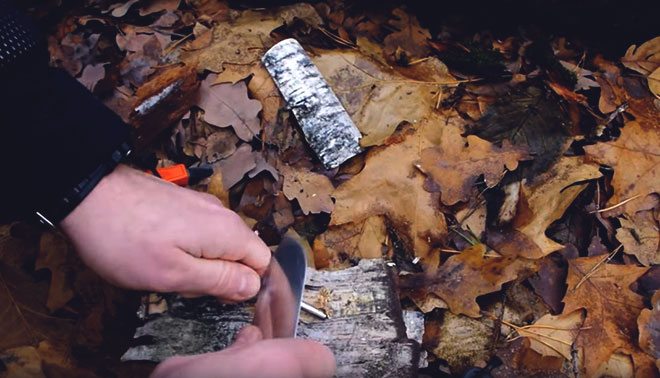
Any metal object can serve as a chair.
The role of a knife can be performed by any metal object: the back of a knife blade, an ax blade, a file. The trajectory of the falling sparks and the location of the harvested tinder must coincide.
Condom
A kind of lens is made from a condom. To do this, the contraceptive is filled with water, given its most rounded shape, tied, and the “rubber glass” catches sunlight. Focusing the beam on a pile of prepared tinder, wait until smoke appears (distance no more than 5 cm from the tinder).
Then they carefully fan the flame, add brushwood and light the fire. Instead of a condom, you can use a balloon.
Flashlight
It’s not difficult to start a fire without matches if you have a flashlight on hand that you don’t mind breaking. More precisely, break the electrical part of the light bulb. The exposed electric arc is brought to the prepared tinder and set on fire.
Skating
This method of lighting a fire without matches came to us from not so remote places. And form a piece of cotton wool into a kind of roller. Roll it intensively on a dry wooden surface until the cotton wool is saturated with oxygen and increases in volume. Oxygen will start a combustion reaction, and the material will begin to smolder.
Soda can and chocolate bar
Sweet lovers do not realize that the usual tandem in the form of a chocolate bar and a can of drink can save lives far from civilization. A clear sunny day and the following steps will help you light a fire with the help of “sweets”:
- remove the chocolate from the wrapper and rub it on the outer bottom of the tin can;
- when the polished bottom shines like a concave mirror, turn it towards the sun and set fire to the tinder spread out at a distance of 3 cm with a caught ray.
Don't be upset if you don't have chocolate on hand. Toothpaste is suitable as a polishing composition.
Wool and batteries
Making a fire without matches is not a problem if you have batteries and a cloth made of natural wool on hand (a strip 15 cm long and 1 cm wide is enough). Rub a stretched piece of fabric with a battery with a power of about 9 V.
Be patient. As soon as the smoldering process begins, blow on the wool and add dry sawdust or leaves. Hurry up, because wool doesn't burn for long.
Firearms
Empty the bullets/shot and some of the gunpowder from the cartridge, fill the cartridge case with crushed cotton wool or dried flowers and fire a blank shot at the fire site. All that remains is to fan the fire and throw the prepared brushwood into it.
Starting a fire with a silicon lighter without gas
If you have a silicon lighter that has run out of gas, the situation of losing matches is no longer critical. The first method of starting a fire requires soft and dry toilet paper. Dense and rough is not suitable. So let's get started:
- remove the protective cover;
- fold toilet paper into 5-6 layers, tear and stack the pieces so that the side of the tear faces one direction;
- in the place from which sparks are emitted when the wheel rotates, press the lighter against the stack (the sides of the gap are directed towards the sparks);
- “roll” your palm along the wheel, striking sparks on a stack of paper (repeat the manipulation until smoldering begins);
- fan until a flame appears.
If you don’t have soft toilet paper at hand, use the second method:
- remove the cover;
- loosen, knead and bend the center of a notebook or any other sheet so that a funnel is formed in the center (this is an important point, without which the task of starting a fire will become more difficult);
- place the lighter horizontally over the paper;
- be careful not to spark, and slowly turn the wheel until a sufficient amount of powder appears on the paper;
- collect a mound of powder in the loosened center of the paper;
- Turn the lighter wheel over the powder until a flash appears and the paper ignites.
Starting a fire with a concave mirror
In field conditions, the following are used as a concave mirror:
- a removed reflector from a car headlight/flashlight;
- concave bottom of the gas cylinder;
- a tablespoon deformed to the shape of a concave mirror;
- a tin can, the bottom of which is polished with a dry, rough cloth.
The “tin can and chocolate bar” method, which was described above, also belongs to this group. Accordingly, fire making is carried out according to the same principle.
Starting a fire with a nail and hammer
During the sharp impact, the metal heats up, and the high temperature spreads to the tinder. To start a fire you will need nails 10 cm long, a hammer, and an anvil.
These items are unlikely to be found in a travel backpack. This means that if you find yourself far from the city, you will have to improvise. For example: a nail is a piece of rod or other metal object; the anvil and hammer are stones (however, in this case, it is more difficult to get fire). Let's look at the procedure:
- Roll the newspaper into a tube and press it with your foot to prevent it from unwinding.
- Hit the nail lying on the anvil several times with a hammer.
- Place the heated nail against the newspaper and leave it until it begins to smolder.
- Inflate the newspaper until a flame appears.
If smoldering has not started, you need to repeat the steps from point No. 2.
Making fire using dry grass
An affordable method that has been used by foresters and rangers for many years. In addition to dry grass you will need:
- water (drinking or rain - it doesn’t matter);
- dry tree bark;
- thin and slightly thicker branches (dry);
- plastic bag;
- plenty of sunlight is the main ingredient.
Using a stone, break a piece of bark until fine tinder is formed. Then divide the particles into 2 piles and place them on two separate pieces of bark. Fill a clean bag with water and wrap it into a sphere.
All that remains is to focus the improvised lens on the sun's rays and shift the focus to the tinder. To increase the burning area, add the second part of the crushed bark and dry grass twisted into a rope.
Using a gum wrapper and a coin cell battery
Foil from a cigarette pack is suitable as an analogue of wrapper. From paper foil, cut an even thin strip that is as long as possible. Sharpen the ends with a knife and attach them to the poles of the battery. Place the sagging part of the foil on the prepared wick.
Attention! When making fire using a battery and foil, you need to take into account the rapid flammability of the method.
With ice
It would seem that there is nothing more stupid than making fire with ice. And how can you light a fire using frozen water? However, experienced travelers claim that this method is a solution for harsh winters, when you can’t even dream of dry grass or leaves.
Having found a piece of pure transparent ice, you need to give it a convex shape and apply it like a lens. The force of the captured sunlight will easily ignite paper, dry cloth or cotton wool.
If you don’t have clean ice, you can make it yourself by freezing drinking water in a shallow saucer and polishing the resulting piece with your hands until it’s transparent. The thickness of the finished lens is at least 5 cm.
Attention! This method requires skill, because the ice melts quickly.
Hand drill
The method has long been used by residents of hot countries. Fortunately, the tropical and equatorial zones are rich in suitable wood. Procedure:
- peel part of a medium-sized branch from the bark and split it into 2 parts;
- make a small slot in one half, in the narrowest part of which, on the outside, make a recess for the drill;
- a stick of medium thickness, 50 cm long, sharpened on one edge - this is a drill;
- place the stick with the slot with its flat side on the pre-prepared wick;
- rest the sharp end of the drill into the recess;
- hold the upper part of the stick between your palms and rub it intensively with rotational movements;
- The embers thus obtained fall onto the wick and are then fanned to produce a full-fledged fire.
Fire bamboo
The method is applicable in regions where bamboo grows. To start a fire in the wild, you will need dried plant stems. The procedure is as follows:
- split a meter-long bamboo trunk into two parts;
- shorten one part (No. 1) by half and make a small through hole in the middle; cut a transverse groove from the outside, right along the line of the hole;
- from the second split piece (No. 2), cut a wide sliver 40 cm long and break it in the center;
- sharpen the side part (No. 2), scrape off the finest shavings from it (it looks like twisted ribbons);
- Divide the shavings into 2 parts and roll into tight balls; then place it inside part No. 1, directly above the hole; press on top with a broken sliver;
- rest your stomach against the edge of trunk No. 2 (the second edge rests against the ground);
- Taking part No. 1 by the opposite ends (with kindling, wood chips), lean it with a groove against the sharp end of the second part;
- carry out reciprocating movements until signs of smoldering appear;
- Transfer the smoldering kindling to dry grass and fan the flame.
Accumulator battery
If you have a vehicle, the problem of losing matches ceases to be relevant. It is enough to make a short circuit between the “+” and “-” . That's it - the job is done. All that remains is to fan the spark that fell on the previously placed wick.
Breeding rules
The most important rule is to locate the fireplace away from the tent and on the leeward side to avoid fire. It is also prohibited to plant in coniferous forests or in clearings with dry grass - this is dangerous due to fire.
When growing on snow or wet ground, first make a layer of stones. In strong winds, you should protect the fire with an improvised wall or shield to retain heat and direct it in the right direction. When precipitation occurs, a film is stretched over it or a roof is made from branches.
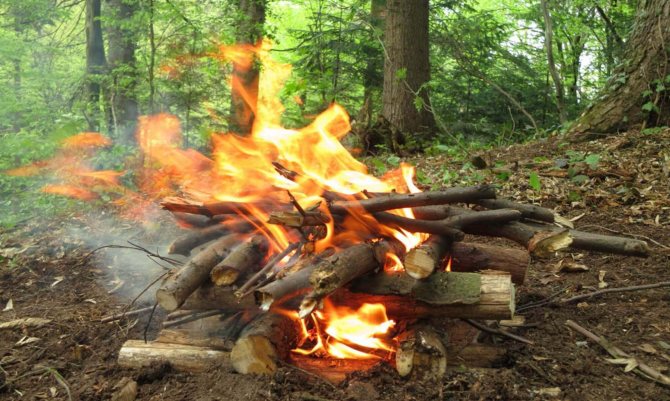
Campfire in the forest
How to make potassium permanganate general rules
To ensure that the solution is suitable, and the process of its preparation does not leave consequences in the form of burns on the skin and unwashable stains, you should adhere to some rules:
1. Use only glassware that is not used for food purposes.
2. Potassium permanganate, which is needed for treatment, is dissolved with warm boiled water.
3. Dry powder crystals burn the skin and leave indelible marks on it, so you need to take them not with your hands, but with a spoon, the tip of a knife or a cotton swab.
4. Water is first added to the solution container, and only then potassium permanganate.
5. The resulting product is stored in a cool, dark place. If possible, it is better to prepare a new composition before each use. Potassium permanganate stains strongly and is difficult to wash off, so it is best to avoid getting it on clothes or skin.
Types of fires
There are many types of fires and their names, however, there are only seven of the most basic and necessary for travelers. Basic examples of bonfires are:
- Hut or pyramid. You can get a lot of heat from it and it is suitable for cooking and heating. Its disadvantage is that it burns out quickly.
- Hole. A hole is dug in the ground, which is lined with stones from the inside to retain heat longer. This type is intended for cooking, baking roast in ashes, boiling water.
- Mole or stove. Perfect for smoking fish. To breed it, you need to dig a hole on a steep slope and bring the hole out to the top of the hill.
- Star. Only thick, dry firewood is used, which is laid out in a star or fan pattern; it burns for a very long time.
- Taiga. You can even plant it in the snow and sleep next to it, as it is very resistant to weather conditions.
- Nodya or fence. Designed for long-term burning and drying of clothes, as it produces a lot of heat.
- Dakota or Polynesian. Its advantages are that it is hardly noticeable to “outsiders”, and also, if you first make a canopy over it, it is suitable for cooking in any weather.
More on the topic: Where to go in November: our choice of places this month
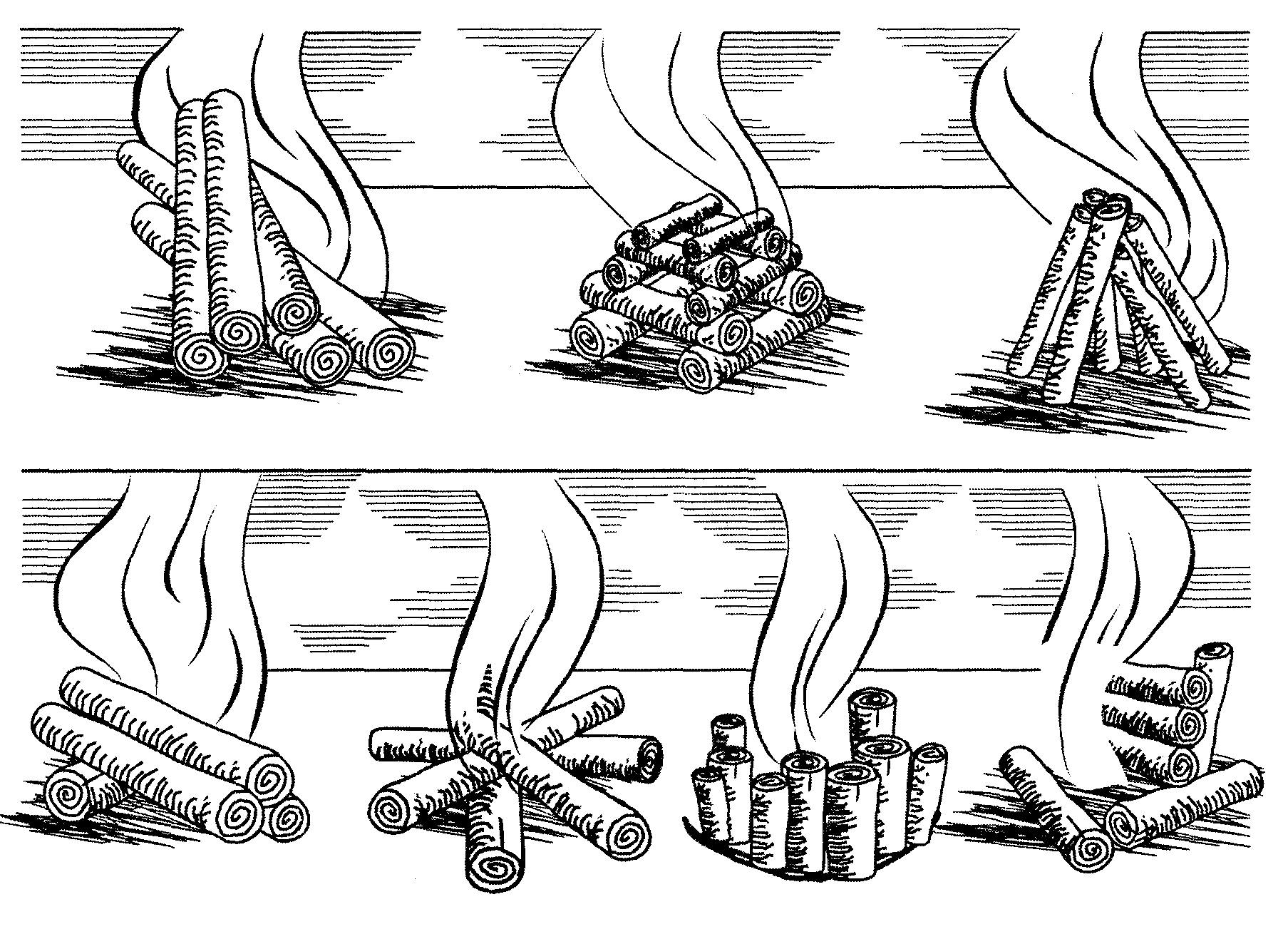
Types of fires
